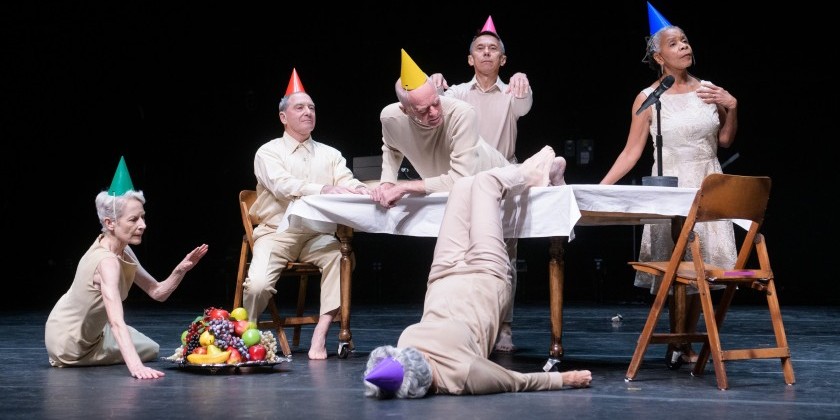IMPRESSIONS: NYTB/Chamber Works at Danspace Project with Choreography by Richard Alston, Antonia Franceschi, Robert La Fosse, and Pam Tanowitz

February 15, 2020
Choreography: Pam Tanowitz, Antonia Franceschi, Richard Alston, Robert La Fosse
Music: Beethoven, Imogen Holst, Claire van Kampen, J.S. Bach, Ravel, Stravinsky
Dancers: Alexis Branagan, Katelyn Conrad, Julian Donahue, Giulia Faria, Genaro Freire, Jonathan Leonard, Mónica Lima, Dawn Gierling Milatin, Erez Milatin, Baylee Sullivan, Amanda Treiber with Guest Artists Stephen Hanna and John Kelly
Musicians: Alice Hargrove, Amy Kang, Sarah Kuo, Kai Ono, Larry Spivack, and Eric Umble
Rebranding from New York Theatre Ballet to NYTB/Chamber Works, this versatile company of twelve dedicated dancers (plus apprentice, guest artists, and live musicians) bolsters its niche appeal. Two world-class works and two world premieres in the cozy St. Mark’s Church bestows the gift of experiencing ballet as an intimate, personal offering.
Artistic Director Diana Byer carries out a curatorial coup in programming gems from Pam Tanowitz and Sir Richard Alston plus two bold commissions. Although the premieres by Antonia Franceschi and Robert La Fosse lack the complexity and nuance of the other works, Byer champions the field’s growth and amplifies women’s voices.
Quirky Double Andante, created for this company in 2015, plays like Tanowitz’s joke on ballet. Dressed by Sylvia Taalsohn Nolan like Blue-Footed Boobies with turquoise pointe shoes for its seven women and ballet slippers for its four men, the dancers lead us into ballet vocabulary with waltzes, pirouettes, and coupe jetés. Then, they surprise us with schizophrenic bursts into vaudeville-style tap, jazzy hip circles, and Scottish folk dance.

Amid the fully fleshed positions and steps, dancers sporadically mark or merely indicate. Amanda Treiber’s legs whisper her pas de bourrée; later, when partnered in a finger turn, she omits the turn itself. Tanowitz places the process of learning material on par with the product, deeming both as worthy of display.
Recognizable movements culminate with the unexpected. Women plunge into fish dives and flex one foot at the lift’s fruition. Erez Milatin concludes a series of difficult pirouettes with a belly flop to the floor. The lady next to me erupted in laughter, yelping during its repeat.
Repeated, too, is the Beethoven Andante from Piano Sonata No. 15 in D Major played live by Alice Hargrove. New choreographic ideas emerge in the second iteration, but recurring motifs help our eye latch onto the bits and pieces that make up this work.

Franceschi’s Uncaged is overstuffed with material. Its best moments emerge when the seven dancers fracture into solos, duets, and trios. Their juxtaposing vocabulary demonstrates the plurality of our passions. A swaying embrace flips to jerky slashing. Giulia Faria slinks and then slams the floor with her palms. When Milatin joins his partner, his presence represents a second layer to the woman’s multifaceted psychological state.
Through the supporting elements, Franceschi taps into her inspiration — the emotional underpinnings in Lee Krasner’s “Umber” paintings. Carmella Lynn Lauer’s beige unitards with feathery black smears evoke the paintings themselves while Claire van Kampen’s score supports the dance’s theme. A mournful cello cries while the piano provides a heartbeat’s constancy. Together with the violin, the trio of musicians leaves us with an unresolved chord.
Alston’s The Small Sonata, adapted from his 2004 Shimmer, delivers the evening’s most sumptuous and viscerally transporting experience. The quartet sparkles in movement and presence as do their Swarovski-encrusted Julien Macdonald skater dresses. The movement quality contains principles of modern dance (weight, suspension) that transform the more staticky attack of ballet.

Treiber’s leg slices a horizontal arc from side to back (a mere rond de jambe), but the simple step elevates to the sublime. Why? Alston and stager Martin Lawrance have coaxed the dancers to capture the important path between the endpoints. Ballet can do this too, but it often focuses on the positions and steps more than the action, quality, or phrasing. Here, to Ravel’s Sonatine, jumps sing, limbs breathe, and gravity gives color to a portrait of our humanity.
Dancers relate. Treiber sees Julian Donahue and trusts him when his back absorbs her cheek or she blindly falls, softly, into his arms. Too bad, that following such authenticity, the dancers revert to iciness in their bows. It negates the realness of the ride.
Delights of La Fosse’s take on Stravinsky’s The Soldier’s Tale (l’Histoire du Soldat) include its many distinctions from the other works. Dancers speak, a Faustian fable is relayed, and new faces (guest artists Stephen Hanna and John Kelly) join the action. Hanna and Kelly as Soldier and Devil, respectively, enact their cartoonish roles splendidly.

But the choreography fell to filler. The score — arranged for clarinet, violin, piano, and percussion — contains ever-changing time signatures, yet La Fosse misses the opportunity to highlight the music’s complexities. The tricky score confused the chorus of dancers as they struggled to find downbeats for their repeated series of marching.
Dawn Gierling Milatin played the role of the Princess. Her dancing captivates throughout the evening as she projects a welcome lushness. Donahue and Jonathan Leonard stand out for their length and breadth.
Kudos to Byer for her commitment to live music. Interspersed between the dances are musical interludes with pieces by Imogen Holst and J.S. Bach. They meet our ears with no electronic amplification. This is live performance at its most tangible.












